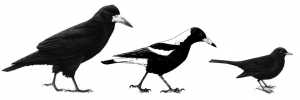Show us your rooks
Greater Wellington is getting on top of rooks in Wairarapa, but still need rural residents to be their eyes and ears to help locate the last few breeding populations.
Greater Wellington pest animal officer Steve Playle says a consistent and methodical approach to rook control have got these crop-munching birds down to small numbers in Wairarapa.
“We want to keep the pressure on them. Any sighting of a rook or rookery is important. It doesn’t matter if you have called us before, we are still very interested to hear from you.”
Typically, breeding rookeries will be located in stands of mature pines or eucalyptus trees. Often they are in close proximity to houses and other farm buildings.
Mr Playle says rook numbers could bounce back quite quickly if the control work stopped.
“Once numbers build up, rooks do a lot of crop damage and become very expensive to control.”
He warns against landowners shooting or poisoning birds.
“They are incredibly smart birds and move nesting sites if they feel threatened. Call Greater Wellington and we will destroy them free of charge.”
Rooks have been in Wairarapa for about 80 years and were introduced to New Zealand in the late 1800s to control pasture insects.
Unfortunately, they also enjoy crop seed, crop seedlings and mature grains.
Mr Playle says the rook problem peaked in Wairarapa in the mid 1990s, with entire crops in South Wairarapa and Whareama being wiped out.
Rooks are larger than magpies and are black all over, and can be identified by its call, “KAAH”.
Any sighting of a rook or rookery is important. Greater Wellington will destroy them free of charge. You can contact Steve Playle on 06 378 2484 or email pest.animals@gw.govt.nz.

